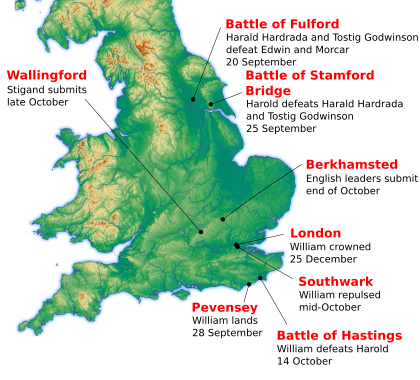Hello ladies and gents this is the Viking telling you that today we are talking about a new series where we are talking about all the wars the English have been in starting with
NORMAN CONQUEST OF ENGLAND
The Norman conquest of England (in Britain, often called the Norman Conquest or the Conquest) was the 11th-century invasion and occupation of England by an army made up of Normans, Bretons, Flemish, and men from other provinces of the Kingdom of France, all led by the Duke of Normandy later styled William the Conqueror.
William's claim to the English throne derived from his familial relationship with the childless Anglo-Saxon king Edward the Confessor, who may have encouraged William's hopes for the throne. Edward died in January 1066 and was succeeded by his brother-in-law Harold Godwinson.
The Norwegian king Harald Hardrada invaded northern England in September 1066 and was victorious at the Battle of Fulford, but Godwinson's army defeated and killed Hardrada at the Battle of Stamford Bridge on 25 September. Within days, William landed in southern England. Harold marched south to oppose him, leaving a significant portion of his army in the north. Harold's army confronted William's invaders on 14 October at the Battle of Hastings; William's force defeated Harold, who was killed in the engagement.
Although William's main rivals were gone, he still faced rebellions over the following years and was not secure on his throne until after 1072. The lands of the resisting English elite were confiscated; some of the elite fled into exile. To control his new kingdom, William granted lands to his followers and built castles commanding military strongpoints throughout the land with the Domesday Book, a manuscript record of the "Great Survey" of much of England and parts of Wales being completed by 1086.
Other effects of the conquest included the court and government, the introduction of the Norman language as the language of the elites, and changes in the composition of the upper classes, as William enfeoffed lands to be held directly from the king.
More gradual changes affected the agricultural classes and village life: the main change appears to have been the formal elimination of slavery, which may or may not have been linked to the invasion. There was little alteration in the structure of government, as the new Norman administrators took over many of the forms of Anglo-Saxon government.
and as always have a chilled day from the Viking.

Comments
Post a Comment